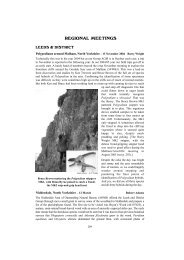Full Contents as pdf File - Natural History Museum
Full Contents as pdf File - Natural History Museum
Full Contents as pdf File - Natural History Museum
You also want an ePaper? Increase the reach of your titles
YUMPU automatically turns print PDFs into web optimized ePapers that Google loves.
more e<strong>as</strong>ily visible close to the path. We also saw large quantities of Dryopteris aemula and<br />
Hymenophyllum tunbrigense along with most common ferns of the region.<br />
92<br />
photo: A.M. Paul<br />
Dicksonia antarctica – mature plants and sporelings at Derreen Garden<br />
We dispersed to our various lodgings and later met up for dinner at ‘White Sands’, the<br />
house where most of the party were staying and which w<strong>as</strong> to become our unofficial HQ for<br />
the next five days. Here we enjoyed a wonderful meal prepared by Karen Munyard and Gill<br />
Smith and chatted in splendid comfort until quite late.<br />
O’Sullivan’s C<strong>as</strong>cade, Killarney (Tuesday) Alan Ogden<br />
The party <strong>as</strong>sembled at a road junction near Killarney at 10.00a.m. to drive a short distance<br />
to the beginning of a walk along a track to O’Sullivan’s C<strong>as</strong>cade on the north-west side of<br />
Lough Leane. We parked our cars by a farm track and stream (00/896902) where there w<strong>as</strong><br />
already a lush <strong>as</strong>semblage of ferns: Osmunda regalis, Dryopteris aemula, D. dilatata,<br />
D. filix-m<strong>as</strong>, D. affinis subspp. affinis and borreri, Athyrium filix-femina, Blechnum spicant,<br />
Polypodium interjectum and the ubiquitous Pteridium aquilinum. Equisetum telmateia had<br />
also been spotted by the roadside. We continued to see specimens of most of these ferns <strong>as</strong><br />
we walked about 2.5 miles to the c<strong>as</strong>cade (00/915884).<br />
The track p<strong>as</strong>sed through an area where large moss-clad boulders covered the ground<br />
beneath large holly trees, making a surreal scene. Many of the boulders were also covered<br />
in mats of filmy fern, mainly Hymenophyllum tunbrigense though we did find smaller<br />
quantities of H. wilsonii. There were remains of a row of buildings made of rocks and<br />
swathed in moss, too decayed to guess at their purpose. It w<strong>as</strong> hard to imagine people<br />
finding a living in this wet, rocky place. Gametophytes of Trichomanes speciosum were<br />
found in a dark dripping cavity, raising hopes of finding the sporophyte by the c<strong>as</strong>cade.<br />
Walking down a very long flight of giant steps we came to the shore of the lough where the<br />
boulders formed a suitable place for us to have lunch. Some people can’t sit still for long<br />
and Steve soon found quills of Isoetes floating near the shore and Equisetum arvense<br />
growing in the shingle. Some of the mossy boulders supported small colonies of<br />
Polypodium vulgare and a single plant of Osmunda regalis w<strong>as</strong> seen. There w<strong>as</strong> evidence of<br />
recent activity of large deer in the woods.<br />
After lunch the c<strong>as</strong>cade w<strong>as</strong> explored enthusi<strong>as</strong>tically, indeed, Steve took a tumble into a<br />
large bramble patch from which he w<strong>as</strong> painfully extracted. Sadly, the Killarney fern w<strong>as</strong>

















